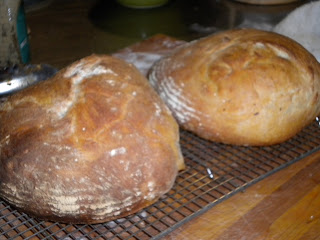Untrimmed brisket with brining crock
A couple of weeks ago at the Norwich Farmers’ Market, Ray Williams from Back Beyond Farm (http://www.backbeyondfarm.com/) had fresh beef brisket for sale. I purchased a half brisket and brought it home to make my own corned beef. It was so good, I picked up a second brisket this past weekend and am trying a slightly different brine to cure this one.
They sell corned beef in the supermarket, but these products are made in large industrial plants where time is at a premium, so speed dictates, and taste and flavor are secondary. Instead of submerging the beef to be corned into a vat of brine with aromatics, and allowing the process to proceed at a natural pace, which can take from 1 to 2 weeks, the muscle is injected with brine, tumbled to distribute the cure, and cryovaced in plastic for delivery to the retailer. Any curing is done in the bag.
I believe there is also a canned corn beef, but I can’t comment on how it is produced or how it gets in the can, so I avoid it.
Different cuts of beef are candidates for salting including silverside, flank, bottom round and brisket, with the latter being the preferred piece. The brisket is the piece of meat that covers the breast or lower chest of the beef, is where the majority of the beef’s weight falls when it lies down, and is one of the eight primal cuts on American beef. As the brisket on a mature animal can weigh 10 to 15 lbs, it is often separated into two pieces, the “flat cut” and the fattier “deckle,” “point,” or “triangular” cut. It is a tougher cut and is usually braised when cooked fresh.
The “corn” in corned beef refers to the coarse salt crystals used to cure the beef, which are about the size of a kernel of corn. Beef was salted to preserve it, the salting drawing out the moisture in the meat, allowing it to keep longer. Corned beef is made by pickling the meat in brine comprised of salt, sugar, herbs and aromatics, allowing it to cure for a week or two in a cool place. Thereafter it is rinsed off and poached at just about a simmer for 2 ½ to 3 hours, or until fork tender. It can be served hot, but when cooled it can be sliced thinly and makes great sandwiches.
Here in the northeast we traditionally accompany corned beef with boiled potatoes, carrots, turnips, beets and cabbage, all cooked in the same broth the beef cooked in, for New England boiled dinner, and, of course, corned beef is an Irish specialty on St. Patrick’s Day.
Corned beef is a cousin to pastrami, which is corned beef rubbed with black pepper and spices and smoked. It is usually served as a cold cut on sandwiches, whether cold or warmed up. Coarse mustard and dill pickles make a common accompaniment.
Here's the recipe I used:
Here's the recipe I used:
Corned Beef (or Tongue)
4-6 lb brisket, flank or beef tongue
1 bouquet garni
1 carrot, chopped
1 onion, chopped
1 celery stalk, chopped
1 leek, chopped
1/2 bulb of garlic
For the brine:
5 quarts of water
1 lb light brown sugar
3 lbs coarse sea salt
1 tsp black peppercorns
1 tsp juniper berries
5 cloves
4 bay leaves
A sprig of thyme
3 tbl saltpeter or Instacure #1
Put all the brine ingredients in a large pot and stir well to dissolve the salt and sugar and bring to the simmer. Remove from the heat and cool completely, refrigerating the brine so its very cold. Place your brisket or tongue in a non-metallic container and cover the meat completely with the cold brine. You will need to use a plate or something to keep the meat submerged. Place in a cool place for 5 to 10 days (pieces less than 6 lbs should be brined for the shorter time period)
Remove the meat from the brine, rinse well and soak in cold water for 24 hours.
Place brined beef in a pot, add the rest of the aromatics and fresh water to cover. Poach very gently on top of the stove (or in a 275 degree oven) for 2 1/2 to 3 hours, or until completely tender and yielding when pierced with a fork.
Serve warm with potatoes, cabbage, beets, turnips and carrots cooked in the broth.











